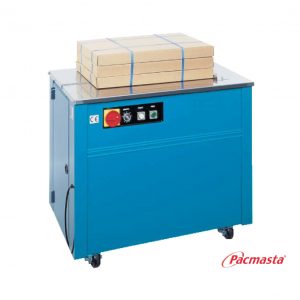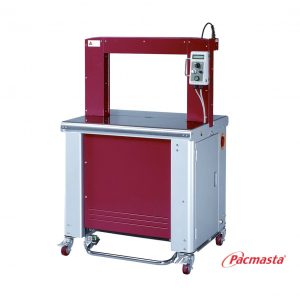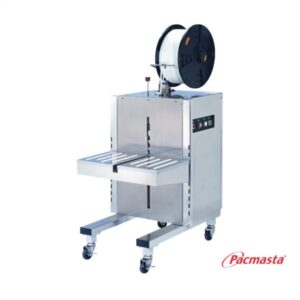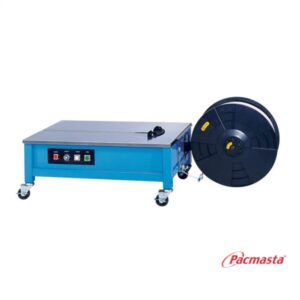Your Guide to Strapping Machines
In this guide to strapping machines, we will be focusing on the types of machines available on the market today. Strapping is used to secure loads to pallets or join parcels and cartons together for security during shipping. There are a few types of strapping used for shipping and transport: baling strap, composite strapping, PET (polyester) strapping, PP (polypropylene) strapping, steel/stainless steel strapping and woven strapping.
Strapping machines are usually used at the manufacturing end of the supply chain by companies assembling their goods for transport out of the factory floor to customers across the country or overseas. Strapping machines cut down the time and simplify the strapping process and improve efficiency.
Powered by electricity, strapping machines eliminate the use of handheld tensioners and cutters. The hard work is done by the strapping machine within seconds and provides a secure consistent application on bulky loads or securing seals on cartons and binding odd-shaped items together.
The machine is preset by an operator, so the correct tension and strength are customised for the consignment.
There are fully automated, semi-automated machines and handheld strapping tools. In this guide to strapping machines, we will focus on electrically operated versions.
Automated strapping machines
Automatic strap machines are a big investment but if you have a busy operation, they will save you time and money, paying for themselves within months. A premium machine can apply a maximum of 65 straps per minute. In one quick action, they strap, seal and cut within the preset parameters by the operator. Once the parcel is set in place, the tension is set, a press of the button completes the strapping process in seconds.
Semi-automated strapping machines
Semi-automated machines are less expensive than fully automated machines. It’s a viable option if you have a lower volume operation. They can strap up to 24 times per minute with some operator participation. These machines will strap, tension and cut to preset parameters after the operator feeds the strapping manually around the parcel or load. It takes longer to strap a parcel than the automated machine but still simplifies the strapping process in one simple action.
Operation of strapping machines
Both the semi and fully automated machines operate in the same manner. From a reel dispenser, the strapping is fed into the machine. Once the consignment is placed in the correct position on the machine, a button is pushed and the strap is applied. Semi-automated machines require the operator to feed the strap over the other side of the parcel and back into the machine to complete the second strap. Automated machines do the whole process for you and take less time. Once the parcel is complete it gets removed and the next one is placed in position for the strapping process. And on it goes, till all your consignments are ready to hit the loading dock ready for departure.
Strapping machines eliminate strap damage such as splitting and bending with a feed system, a strap tensioning device and cams to prevent scratching. Most strapping machines are portable, mounted on casters they can be wheeled around to different workstations as needed. They can come in different sizes, from light-weight to heavy-duty.
Structures of strapping machines
There are various types of strap machines available. Low table strapping machines are built closer to the ground to allow easy strapping and shifting of tall or heavy boxes. Tabletop strapping machines are for easy to lift, smaller boxes and parcels, saving a lot of back bending. The higher-end models come with an adjustable table height. Side action strapping machines have the strapping head mounted on the side of the machine frame to protect it from dust and water which means it is great for dusty, moist or harsh working environments such as sawmills, brick and tile plants.
Arch strapping machine versus strapping table
Arch strapping machines can be either automatic or semi-automated. Their strapping time is much quicker than tabletop strappers and they are less reliant on an operator. They are a bigger investment and are more suitable for large supply chain operations.
The dimensions of the arch are dependent on the size of the goods being strapped. The internal dimensions of the arch will inform your choice of machine. To determine the speed of the machine you need, working out the strapping rate you require to keep up or grow your operations is essential.
Strapping tables are usually semi-automated and require some form of manual operation. They are more suitable for low to medium volumes of production. Position the goods on the table, manually placing the strap in position and pressing the button or foot pedal to strap the goods, remove the item from the table and repeat the process over. These machines are less expensive and highly versatile. Because these machines don’t have an arch which predetermines the maximum size of the items, volumes can vary.
If your business is ready to move on from hand-held strapping tools, then strapping machines are your answer to speeding up your processes and increase your efficiency. Coupled with portable flexible conveyor belts, your strapping process will be streamlined, safer and faster. Your staff can be assigned to other processes in your operations while your machine does the heavy work for you.
We hope this guide to strapping machines has helped you to decide on how soon you need to upgrade your strapping processes and what type of machine you require to make it happen.




